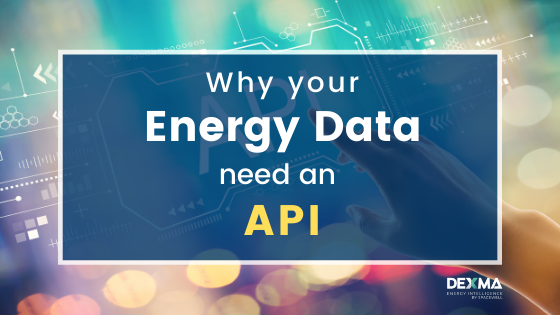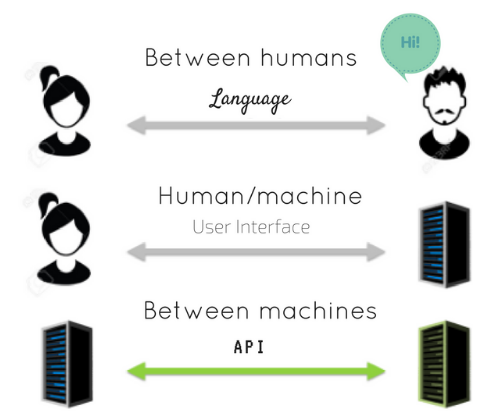It’s 2021, and by now smart meters are probably flooding your utility with zetabytes of data. Fantastic, right? But wait – that data deluge is totally worthless if you don’t do anything with it!
An open API for energy can help by maximising the value of the massive amounts of data collected by large energy services companies and utilities by exposing it to brilliant developers that want to experiment and create amazing and useful applications.
Chances are you’ve heard the acronym API being thrown around left right and centre, but let’s recap in case you don’t know what those letters actually mean…
What is an API?
API stands for Application Program Interface. It basically refers to the definitive code that enables software programs to talk to each other.
Software development changed forever when REST and SOAP standardisation protocols were introduced 20 years ago (check out this amazing infographic explaining the difference). For us energy industry players, this was a huge leap: suddenly we could send and receive standardised information across any device, meter, utility or other energy-related businesses in real time.
If an API is open, it means it’s published on the Internet, so anyone can build applications “on top” of it, or integrate existing ones that extend the original application’s functionality or provide additional features.
For instance, DEXMA is one of the few EMS providers that offers its own open API for energy data, among other kinds. Even enterprise resource planning (ERP) software providers can connect directly with DEXMA Platform. Previously, integrations between DEXMA and ERP software like SAP were accomplished using a system integrator.
“As our partner community began to grow, we decided to expand DEXMA Energy Intelligence to better fit their needs,” explains DEXMA CEO Joan Pinyol: “This led to the decision to upgrade the existing API. Now we offer a fully-managed REST API so that our partners can build as many features as they want on top of DEXMA.”
Still unfamiliar with DEXMA Platform? Access your free demo here:
Why Should I Invest in an Open API for Energy Data?
So many reasons! First and foremost, your customers are keen to set sound energy management goals, identify cost-effective energy efficiency measures and target their efficiency investments in a smarter way. Need proof? Just look at the insights we got from DEXMA Detect (formerly called Energy Grader) showing this huge interest!
APIs are not only essential to build a holistic, end-to-end energy management end-user experience for customers, but also strategically important for utilities and ESCOs that are hungry for innovation.
As the energy management market becomes an increasingly messy battle among multiple ecosystems led by tech giants (think Microsoft and Google, who released an energy data API way back in 2010) and ESCOs, choice of API strategy can influence your size and growth and become a significant differentiator.
Finally, APIs can help you keep up with the incumbent competition. Big ESCOs and utilities such as Duke, Pacific Gas and Electric (PG&E), Progress, Southern California Edison (SCE) and DTE Energy have been using or working with open APIs for several years already.
Benefits of Partnering With an Open API-Enabled EMS
But wait! Before you start your programmer hiring frenzy or poaching your best ops developers to work on your secret internal innovation API platform project, allow us to save you a bunch of time (and headaches!) by suggesting that you integrate with an existing open API.
We know – you have a huge rockstar development team. But why spend so much time and resources developing your own platform if you can use one that is already running, fully customisable and armed with an ultra-flexible open API that enables you to integrate whatever you need?
Penetrate the energy efficiency market faster
We hate to break it to you guys, but risk-averse companies like utilities are not exactly the best at applying the lean methodology (iterating quickly) that building a robust energy API often requires. You tend to over plan, which leads to spending way more resources than necessary to cover every possible scenario you can think of. What’s worse, this tendency also limits positive unknowns that can sometimes result in the most interesting innovations!
We’re not saying due diligence shouldn’t be done before leaping, but enterprises will generally find it more challenging than agile software experts when it comes to realising API innovations, suggests Kin Lane, also known as the API Evangelist.
This has been our experience at DEXMA too. “Integrating with our API helps our partners work simpler, faster, and in a more structured and organised way,” says Guillem Corominas, DEXMA’s Development Director. “The time they need to develop a new app has been reduced by around 40%.”
Easily integrate any device or system to boost CX
With an open API for energy data, integrating any metering device is a snap. No matter what energy challenge your next prospect has, you will be able to manage their data more easily and in real-time.
Even more importantly, open APIs can easily connect to any big corporate system like BMS, SCADAs, ERPs, BIs (need a refresher?) which can add energy insights to existing customer intelligence. Here you would use the API internally.
For example, your utility can start sending a customer’s energy data to DEXMA via open API, analyse that customer’s energy behaviour and then send the results back to your BI platform or CRM to create customised offers or personalised recommendations to serve that customer better.
Not only does the open API deliver more value to your clients, but it enables you to become a data-driven utility, including data that you understand best: energy analytics, of course!
My EMS Provider Already Has an API…
Maybe your energy management software provider already has an API and you are already building apps on top of it. But does that EMS include a marketplace to sell that app you spent tons of time and money developing?
With DEXMA’s REST API, you already know that your developers can build complex, ultra-customised analytics and Big Data features directly into their web, mobile, or Internet of Things (IoT) applications. But the best part is that your business development teams can also access the DEXMA Energy Apps Market to offer the latest products or features directly to your customers.
For example, there’s an app that allows users to maximise solar energy use (Microgrid App) or perform Demand Forecast Assessment (DFA), Automatic and Semi-Automatic Demand Side Management (SaDSM/ADSM), Energy Procurement (EP) and Demand Response (DR) in the eQualtiq project. Check out the growing number of apps already available on the DEXMA Energy Apps Market.
Open API security
“OK, I see that APIs really are useful and everywhere, but how do I know my integrations and data points will be secure?”
I’m so glad you asked!
“DEXMA’s highest priority is taking the best possible care of our customers’ data, which is why we built the API with data security and privacy in mind,” says Guillem. “For example, users need to take specific steps in order to authorise a hardware device or meter to “talk” to “DEXMA.”
On the other hand, it’s also important for our partners to help and educate their end customers so that they feel comfortable sharing their energy data with third parties like DEXMA. Integrating with the APIs themselves first can help them do that in a better way.
Don’t just take our word for it -“Whether the utility companies can see it or not, open data and APIs will be central to their continued success.” according to our friend Kin Lane, the API Evangelist.
In terms of externalising and shortening energy application development, an API is simply a must. Due to the sheer volume of energy data being received, real-time integrations that your customers expect cannot be done the old-fashioned way with file import or export anymore.
Keen to get started? Book a free consultation with an energy analytics expert to learn more about our flexible, open API:






